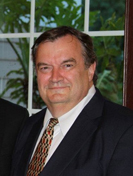
Lyle N. Long, Ph.D.
Distinguished Professor of Aerospace Engineering and Mathematics
Director of Computational Science Graduate Minor
229C Hammond Building
Penn State University
University Park, PA 16802
Phone: 814-865-1172 / Fax: 814-865-7092
E-mail: lnl@psu.edu
Professor Lyle Long has a soapbox issue. For almost 25 years, Long – now a Penn State distinguished professor of aerospace engineering, bioengineering and mathematics -- has been preaching the virtues, and increasingly the necessity, of teaching computer engineering to undergraduate and graduate students.
“We in academia need to be honest with students about where the jobs are and, more generally, about how complex systems such as aircraft, spacecraft, and other safety- and mission-critical systems are actually designed, built and operated,” he said.
Under Long’s leadership, Penn State in 2006 created a graduate minor program in computational science that enrolls students across a spectrum of disciplines including not only engineering but math, physics, chemistry, and other departments. Long is still the director of the program and would like to see it taken advantage of by students in disciplines beyond science and engineering -- psychology, for example.
Professor Long first recognized the pervasive importance of computers when he was a newly minted doctor of science from George Washington University working as a senior aerodynamics engineer at Lockheed Corp. in Burbank, Calif. It was 1985, and he organized a team of 10 people working on issues in fluid dynamics, visualization, structural dynamics and electromagnetism to learn about using high-performance computing to support their work.
Today, with computers thoroughly integrated not only into sophisticated engineering systems but into society, Long is surprised that so few academic institutions have incorporated adequate formal instruction in both software and systems. In a 2008 article for “CrossTalk, The Journal of Defense Software Engineering,” Long writes that “software disasters cost the United States billions of dollars every year, and this will only get worse because future systems will be more complex.” To buttress the point, the article notes that the Boeing 777 has 1,280 onboard processors that use more than 4 million lines of software, the F-22 has more than 2 million lines of software onboard, and the wiring harness of an aircraft is often more complex and difficult to design than its structure.
In conversation, Long takes a look at the larger picture and points out that technology changes at an exponential rate while the human lifespan is, by comparison, more or less constant. “If we in the professoriate don’t force ourselves to keep up, to keep learning, we soon get hopelessly behind,” he said. “That’s a disservice to our students and in fact represents the abnegation of our role in society.”
Besides the doctorate from George Washington, Long holds bachelor’s degree in mechanical engineering from the University of Minnesota and a master’s degree from the department of aeronautics and astronautics at Stanford. He joined the Penn State faculty in 1989. Long’s doctoral research was on rotorblades in helicopters, specifically a simulation of compressible aerodynamics using the wave equation from acoustics. Today, Long’s research interests have widened to encompass intelligent systems and cognitive architectures for mobile robots, legged robots, large-scale spiking neural networks and learning, computational fluid dynamics, and object-oriented programming. Among his current projects is creating a computer simulation of the human nervous system, represented graphically by a blue, green and yellow pattern that resembles psychedelic snakeskin.
Associated with that effort is another to create a computer model of the neural network behind human vision. This could result eventually in sighted robotic systems that would be useful in all sorts of applications, including autonomous aerial vehicles, terrestrial robots, and underwater robots. Ultimately, the goal of Long’s research is, as he puts it, to “pack more and more intelligence into robots.” The U.S. Army, for example, would like to have robots capable of searching for things on their own.
The third of six children of a truck driver and a homemaker, Long grew up in a small town in Wisconsin and moved with his family to Minneapolis when he was 12. He was “in love with cars,” he says, and bought his first, a VW bug, when he was only 15. That was soon followed by an MG Midget, and he worked his way through the University of Minnesota as an auto mechanic. Today he lives less than a mile from Penn State’s University Park campus, but admits that when he commutes in his red ’77 Corvette, he sometimes goes by way of Bellefonte, located 15 miles northeast.
Long met his wife, Laura, at Stanford, and she works as a registered nurse. They have two sons, Robert, who is studying mathematics and music in college, and David, in graduate school pursuing a Ph.D. in chemistry.
During the 2007-2008 school year, Long was designated a Moore Distinguished Scholar at the California Institute of Technology, which enabled him to spend a year going to seminars, thinking, reading, and developing computational neuroscience software. The time also gave him an opportunity to work on an important but controversial paper. Its topic? The impending creation of conscious machines.
Long is a fellow of the American Institute of Aeronautics and Astronautics and of the American Physical Society. With a team from Penn State and Thinking Machines, he is a winner of the Gordon Bell Prize from the Association for Computing Machinery and the Institute of Electrical and Electronics Engineers for peak performance in a high-performance computer application.
